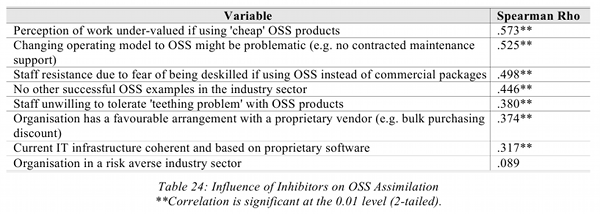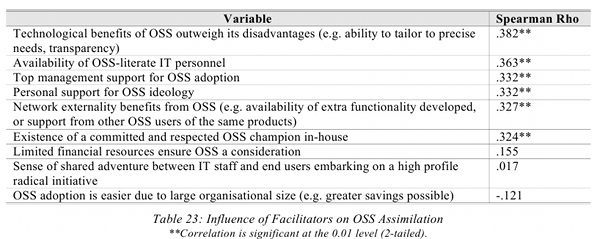As a followup of my previous post (available here) on concrete data on TCO and results of our past EU projects in the area, here is a more detailed contribution of some of the aspects that we studied in Public Administrations, starting with an explanation of my assertion that “real world TCO of an OSS migration is roughly twice the actual monetary cost” that I mentioned, and that raised quite some interest. First of all, here is a more detailed table with the tangible versus intangible costs:

On average the costs are very equally shared, with one exception in an Italian Province that had higher tangible costs (as it actually paid external contractors and services for most of the OSS activity) and a small municipality that for budget reasons shifted most of the work internally as immaterial expenses in a very significant way; the measure is also skewed by the small size of the experiment for this particular case. The measures performed in the other experiments confirm the approximate range of tangible vs. intangible; while there is some variability, the relative error is quite small.
Some interesting facts also emerged in the evaluation of negative and positive factors for adoption of OSS; in fact, this is part of the set of measurements that became the basis of our set of best practices for OSS adoption (that you can find described here, here and here). Let’s start with the negative ones:

The first observation is the fact that being in a risk averse industry sector is basically not a really significant factor (and as a counter-example, banks and financial services are substantial OSS users, and extremely risk-averse). The other factors are extremely significant, that is they explain a substantial percentage of the variability (that is, if a migration is successful or not). You can also find that most of our best practices do have a direct connection with some of the negative factors:
Perception of work under-valued if using “cheap” OSS products -> the best practice is “Provide background information on OSS: A significant obstacle of OSS adoption is the acceptance by the user, that usually has a very limited knowledge of open source and open data standards. In many cases, OSS is perceived as lower quality as it is “free”, downloadable from the Internet like many shareware packages or like amateur projects. It is important to cancel this perception, and to provide information on how OSS is developed and what is the rationale and business model that underlie it.”
Staff resistance due to fear of being de-skilled -> the best practice is “Use the migration as an occasion to improve users skill: as training for the new infrastructure is required, it may be used as a way to improve overall ICT skills; in many companies and public administrations for example little formal training is usually performed on users. This helps not only in increasing confidence, but can also used to harmonize skills among groups and in general improve performance. This may rise some resistance from the so called “local gurus”, that may perceive this overall improvement as a lessening of their social role as technical leaders. The best way to counter such resistance is to identify those users, and suggest them to access higher-level training material (that may be placed in a publicly accessible web site, for example).”
You will find that for each of these negative factors there is a specific best practice designed to help reduce its impact; taken all together, it is possible to increase the probability of success substantially with very few (and simple) methods. As for the positive factors:

It is easy to see that economic consideration are of relatively limited importance when compared with the other positive factors, and this gives value to my own theory that flexibility and vendor independence are stronger factors than economical ones (even considering that sometimes the threat of going to OSS is used to increase the discount by proprietary vendors during negotiation). Among the factors that map directly to our best practices:
Availability of OSS-literate IT personnel: “Understand the way OSS is developed: Most project are based on a cooperative development model, with a core set of developers providing most of the code (usually working for a commercial firm) and a large number of non-core contributors. This development model does provide a great code quality and a fast development cycle, but requires also a significant effort in tracking changes and updates.”
Top management support for the migration: “Be sure of management commitment to the transition: Management support and commitment have been repeatedly found to be one of the most important variable for the success of complex IT efforts, and FLOSS migrations are no exception. This commitment must be guaranteed for a time period sufficient to cover the complete migration; this means that in organizations where IT directors are frequently changed, or where management changes in fixed periods of times (for example, in public administrations where changes happens frequently) there must be a process in place to hand over management of the migration. The commitment should also extend to funding (as transitions and training will require resources, both monetary and in-house). The best way to insure continued coordination is to appoint a team with mixed experiences (management and technical) to provide continuous feedback and day-to-day management.”
Some best practices provide a reduction of the impact of negative factors and at the same time increase the impact of positive ones, like “Seek out advice or search for information on similar transitions: As the number of companies and administrations that have already performed a migration is now considerable, it is easy to find information on what to expect and how to proceed” covers both the negative “no other successful example of OSS migration in the same sector” and the positive “support from other OSS users”.
As a conclusion: there is a way to substantially increase the probability of doing a successful OSS adoption/migration, and the way goes through some simple and fact-based methods. Also, the spectre of ultra-high TCO for OSS migration can be banned through a single multiplication, to get the real numbers. If some company claims that OSS costs too much, first of all ask where they get their data from. If it is from a model, show them that reality (may) be different.
Of course, if you insist of doing everything wrong, the costs may be high. But I’m here for a reason, no? ![]()